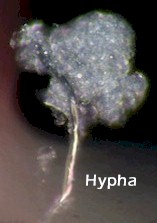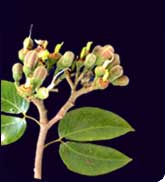Classification:
There are differing methods for classifying
living forms on this Planet. According to some of these,
plants and fungi both belong to the Kingdom of Plantae (also
sometimes called Vegetabilia), but some scientists recognize
five or six kingdoms of nature, in which case, fungi are regarded
as a separate kingdom, somewhere in between plants and animals. With
time, there has been more and more tendency to regard fungi as
somewhat more like animals than plants.
Fungi:
All molds are fungi, but not all fungi are molds. The
Kingdom of Fungi also includes yeasts and mushrooms as well as
mildew, rust, and smuts. There are
about a million species of fungi. Less than 400 of these
have been studied in relationship to human illness.
Mycology
The study of fungi is called mycology. Myco
refers to fungi and logy comes from the Greek word for study.
Spelling:
Mold may also be spelled with a "u",
i.e. mould, and there are good arguments for preferring this
spelling, but the more common spelling in the U.S. is mold.
Characteristics:
Mold has attributes that resemble plants except
that molds do not have chlorophyll. They get their nutrients
from eating organic matter rather than through photosynthesis. However,
unlike animals, molds do not have stomachs even though they have
unique digestive activities that allow them to eat, digest, and
excrete. The consensus at this time is that fungi are a
bit more animal-like than plant-like.
Structure:
Molds are microscopic unless found in great
numbers, in which case one sees the evidence of mold presence
even though the individual specimens require microscopic examination. They
usually appear to be cottony or woolly. Colors vary enormously
and may change during different phases of growth.
Molds consist of spores which
are comparable to seeds because reproduction occurs through a
germination process that leads to radical increases in spore
populations called colonies. These
are sometimes readily visible. Examples would be the mold
on bread or fruit or the classic images of stachybotrys growing
on walls. These colonies appear dusty and with only slight
disturbance, spores become easily airborne.
Spores can be found in varying shapes and sizes
but are more or less consistent within a particular type of mold. Reproduction
can be "sexual" or "asexual." Sexual
reproduction involves fertilization of a female by a male, a
mating. Asexual reproduction usually occurs through internal
division or modification of the hypha.
Hyphae
 The
word hypha comes from the Greek word for web. This is the
part of the fungus that is vegetative. Extending from the
spores are filaments called hyphae (singular
is hypha). These are tube-like and they penetrate the substance
being consumed by projecting into the food, building materials,
or tissues— basically any organic matter—and providing
a sort of conduit for moving nutrients to the spores. Enzymes
are secreted inside the hyphae so that food arriving for the
spore is predigested or semidigested.
The
word hypha comes from the Greek word for web. This is the
part of the fungus that is vegetative. Extending from the
spores are filaments called hyphae (singular
is hypha). These are tube-like and they penetrate the substance
being consumed by projecting into the food, building materials,
or tissues— basically any organic matter—and providing
a sort of conduit for moving nutrients to the spores. Enzymes
are secreted inside the hyphae so that food arriving for the
spore is predigested or semidigested.
A mass of hyphae is called a mycelium. Basically,
the presence of hyphal structures means the mold is alive, eating,
and colonizing. This causes danger to property
and health.
Infection:
There are three main mechanisms of human and
animal infection:
- Ingestion.
- Contact with the skin, especially if there
are open wounds on the skin.
- Inhalation of airborne particulates.
Ingrid Naiman
Lesson
#2 




 The
word hypha comes from the Greek word for web. This is the
part of the fungus that is vegetative. Extending from the
spores are filaments called
The
word hypha comes from the Greek word for web. This is the
part of the fungus that is vegetative. Extending from the
spores are filaments called 
